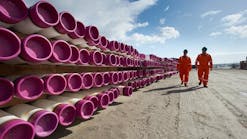MANAGEMENT & ECONOMICS: Public share price collapse leaving oil industry open to private financing
The era of the private wildcatter may be about to return to the petroleum ind-ustry, replacing public equity as a major source of capital. The shift is not a result of wild-eyed greed, but largely because traditional capital sources are leaving the field wide open for private money.
Private money built the global petroleum business in the late 19th and early 20th centuries, and it was not until the later creation of the public shareholder corporation that public common and preferred equity capital began to replace private funding.
Private money answers only to its owner. The owner sets the risk level and time horizon for the expected return and shares the reward/ failure with no one else.
Shareholder money goes through an intermediary - corporate management - and carries the expectation of growing returns, or at least stable returns. In public equity, corporate management sets the risk level and must justify its efforts to the wider stock market on a quarterly basis. Shareholders can then choose from among different corporate risk profiles available in the stock market to create a balanced portfolio. Public shareholders generally are risk-averse and severely punish firms that fail to meet the quarterly profit projections by selling shares.
A shift in the equity market, where shareholders continue to back out of energy stocks, is forcing corporations, mostly in the US but also in Europe, to adjust to the new risk environment. The result is that the petroleum industry, to some degree mirroring the rest of the global economy, is entering a period where public equity is searching elsewhere for value.
New growth expectations
The shift in risk began with the speculative escalation in value of public dot-com and telecommunications shares. Dot-com and telecom firms were the new money machines and carried the vision of a new economy. The recent high-profile collapse simply confirmed that capital has a natural limit for investment.
However, high profit expectations connected with the dot-com and telecom investment bubble pulled money from oil and gas companies' equity pool, to the point that they were seen as poor investments.
The market punished production companies if they didn't produce the kind of financial results that dot-coms and telecom companies were generating. Even after dot-com and telecom stock prices collapsed, that expectation continued because energy equities became the next speculative target for generating value growth.
As investment money searched for the next 'best thing,' oil and gas prices climbed through the late 1Q - early 2Q 2001 period. Energy companies enjoyed buoyant share prices earlier this year, until demand collapsed and storage volumes rose. Share prices quickly dropped back.
Meanwhile, many producers and larger service companies used the brief period of high quarterly returns to buy back public shares and pay down debt. Today, energy producers and service companies are having to make do with internally generated capital.
Many oil companies are hoarding large cash positions because the markets are not rewarding them for the longer-term higher-risk investments they have made. In some cases, producers can make greater margins with in-house money-trading operations than from oil production and refining.
Assets and properties
With this competition for higher energy business investment returns, oil and gas producers resorted to two significant strategies: property churning and asset acquisition.
A widespread market in onshore and offshore oil properties developed late last year, aided by the development of an auction environment on the Internet. Harvesting and churning of producing properties became the newest game. Property trading sets the level of oil field value through successive property owners and operators.
The process is an efficient harvesting mechanism that assures efficient draining of oil properties by smaller and smaller companies, as the fields deplete. However, the churning of properties does not create new value and does not expand the available petroleum supply.
Adding to the turnover of existing reserves is the diminishing size of developed reserves. Chasing dwindling deposits of oil and gas can be a costly game. Producers rarely are able to grow simply by developing existing properties.
Producers have found asset acquisition to be a low-risk growth strategy. The process involves acquiring other producers or asset owners, laying off the duplicate workers, churning the properties, then repeating the process. The effort works if the acquired company has undeveloped reserves, but if the acquired firms also are churning properties, the merger has diminishing returns.
Wider forces
Wider forces at work in today's global economy are depressing public shareholder interest in oil and gas industry equities and opening the door for the large-scale emergence of private capital:
- Softening world economy: The current global environment for public capital is weak. Stock markets around the world are falling to lower levels, with no forseeable recovery on the horizon. Speculation for such a turnaround ranges from 4Q 2001 to 2Q 2002.
- Relying on spending: The global economy, whether it wants to or not, is relying on US consumers to continue the spending habits of recent years in order to soak up the outstanding global inventory of goods. As a last resort, US consumers are tapping housing equity as the final store of value to sustain spending. This short-term strategy, most recently labeled by analysts as 'cash-out mortgage financing,' also has a natural limit. When jobs disappear, the 'debt balloon' collapses leaving banks with non-performing mortgages.
Petroleum markets
The cascade of impact from the wider world economy to regional energy sectors has begun. The softening economy has dropped oil prices and taken the pressure off natural gas and oil inventories. OPEC has responded by reducing oil supplies to support their target price range - so far successfully.
At the same time, OPEC market stabilization efforts are creating uncertainty and forcing oil producers to respond. Non-OPEC oil producers of all sizes are controlling what they can, and some have reached back into the gas exploration and development business to seek that stability. To reach short-term goals, producers and service companies are trying to maintain share prices (improve price-to-earnings ratios) by buying back shares.
A secondary effect to this focused share buyback is the 'starving' of contract-dependent service and drilling companies, since only necessary development projects are undertaken, and little is committed to exploration.
Opportunity
So, where does this avenue of public-to-private risk shift, collapsing public equity values, property churning, and asset acquisition lead? Publicly held companies are playing it safe and competing for capital instead of actively pursuing risky exploration (long-term deepwater investments excepted). New incentives for risk-taking are being developed by anxious country leasing agencies (deep shelf royalty relief in the US, for example), and time will tell whether the incentives are sufficient to attract renewed drilling.
At this point, the private wildcatter has a wide-open door to take up the risk role vacated by public shareholders, because the private wildcatter can accept the longer payback horizon required by exposure to high-risk opportunities. With private backing, knowledgeable risk takers have a host of opportunities to choose from in the coming years.






